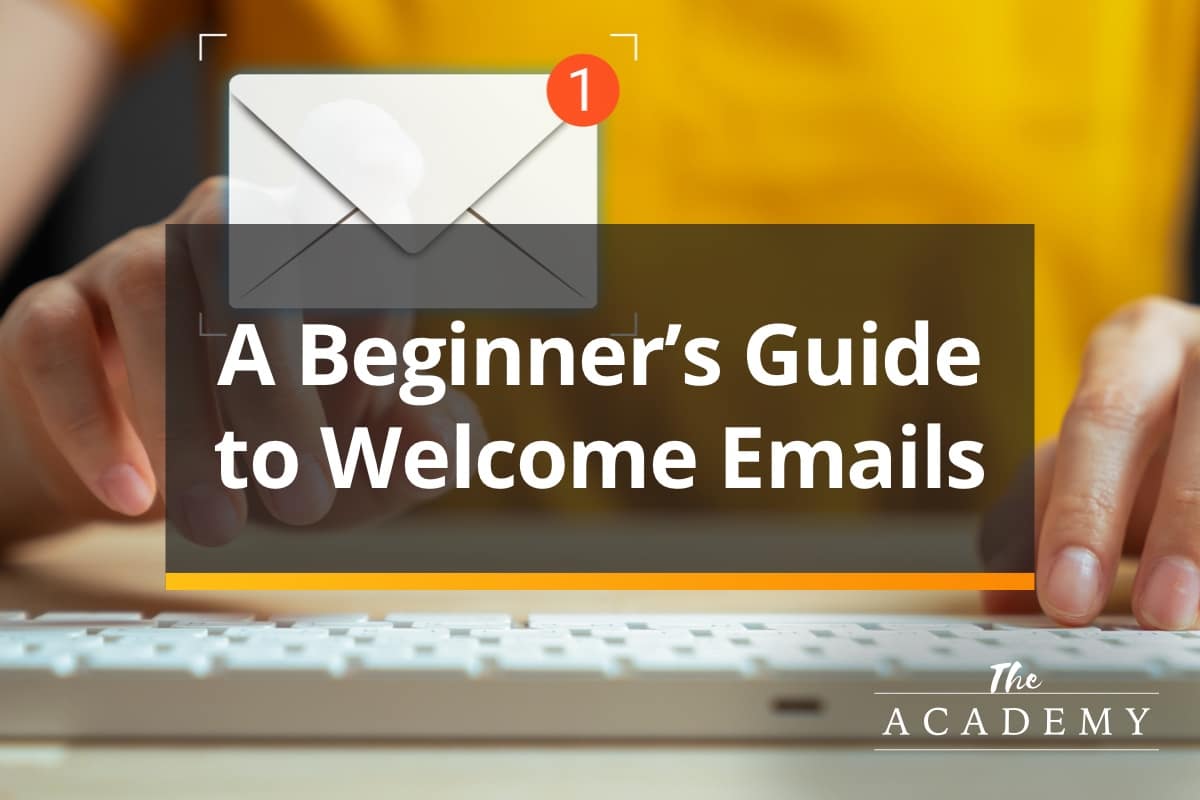
Delving into sophisticated email marketing strategies beyond the conventional email newsletter can sometimes feel overwhelming for business owners and marketers. But there are many opportunities to use email to engage your customers and you can begin with a welcome email. Welcome emails serve as a crucial component of your marketing plan. Email can shape the foundation for your business relationship with your customers right from the initial interaction.
Let us help you understand the importance of welcome emails, how to write one, and how to avoid common pitfalls.
Understanding Welcome Emails
As mentioned, welcome emails serve as the initial point of contact between your business and a new customer or subscriber. It is the first impression that you make on them, setting the tone for your future relationship. This powerful but often forgotten step allows you to establish a connection with your audience, capturing their attention and guiding them toward their next interaction with your brand.
One of the key benefits of welcome emails lies in their exceptional open rate. Consider the average open rate for ‘Welcome Emails.’ The data suggests an open rate standing at a minimum of 50% or as high as 68.6%. (Oberlo) At a minimum, this indicates that recipients demonstrate a propensity towards opening these initial messages at a rate that is 75% higher than for other types of marketing emails.
By crafting a well-designed welcome email, you have an opportunity to showcase the essence of your brand identity and immediately create trust — a rare commodity. From the moment subscribers receive this message in their inbox, it should exude professionalism while reflecting your unique voice. Consider incorporating elements such as compelling visuals or personalized greetings to create an instant connection with recipients.
Welcome emails can serve as more than just a simple greeting; they can also act as valuable resources for new subscribers. You should never miss an opportunity to return value in some way and your welcome emails are an easy way to do just that. By providing helpful information or exclusive offers within this initial communication, you are demonstrating genuine value right from the start. Whether it’s offering access to insider tips or presenting discounts on upcoming products and services – these gestures will begin to build trust and further the engagement with your brand.
The Importance of Welcome Emails
Welcome emails play a crucial role in marketing strategies, far beyond being mere, generic formalities. In fact, they have the potential to significantly impact revenue generation by driving up to 320% more sales per email compared to other promotional emails. (Wordstream) This staggering statistic underscores the immense value that welcome emails hold for businesses.
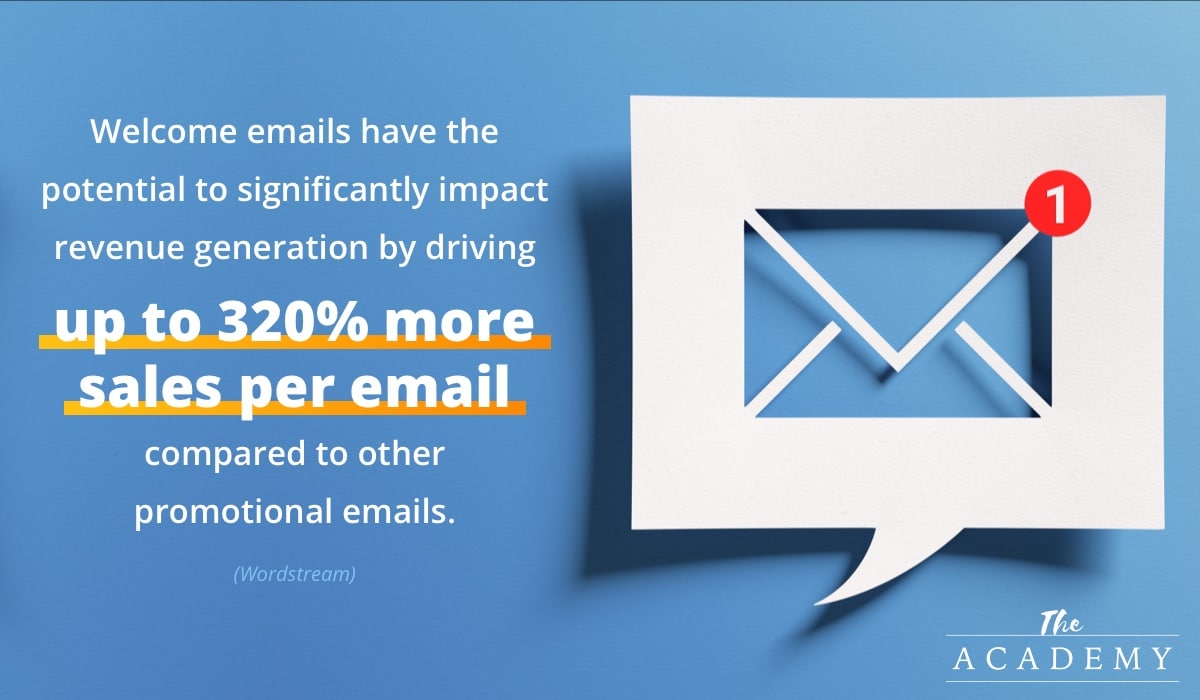
Welcome emails are instrumental in enhancing email marketing engagement rates. Research reveals that an astounding 74% of customers actually expect to receive a welcome email upon subscribing to a brand’s communication channels. (Wordstream) This finding demonstrates the high level of anticipation and importance placed on these initial interactions with customers.
Beyond their revenue-driving potential and ability to engage customers, welcome emails also offer invaluable insights into consumer behavior. By analyzing metrics such as open rates or click-through rates associated with these initial correspondence pieces, marketers can gain valuable data-driven insights about their target audience’s preferences and interests.
Welcome emails serve as simple, but pivotal tools within any comprehensive marketing strategy. From increasing revenue per email and improving engagement rates to fostering meaningful customer connections and obtaining actionable analytics; investing time and resources into crafting impactful welcome messages undoubtedly reaps substantial benefits for businesses across various industries.
Best Practices of an Effective Welcome Email
There exist several elements that can significantly improve your welcome emails. These supplementary ingredients, when integrated effectively, can serve to fine-tune the welcome email, optimizing its appeal and impact.
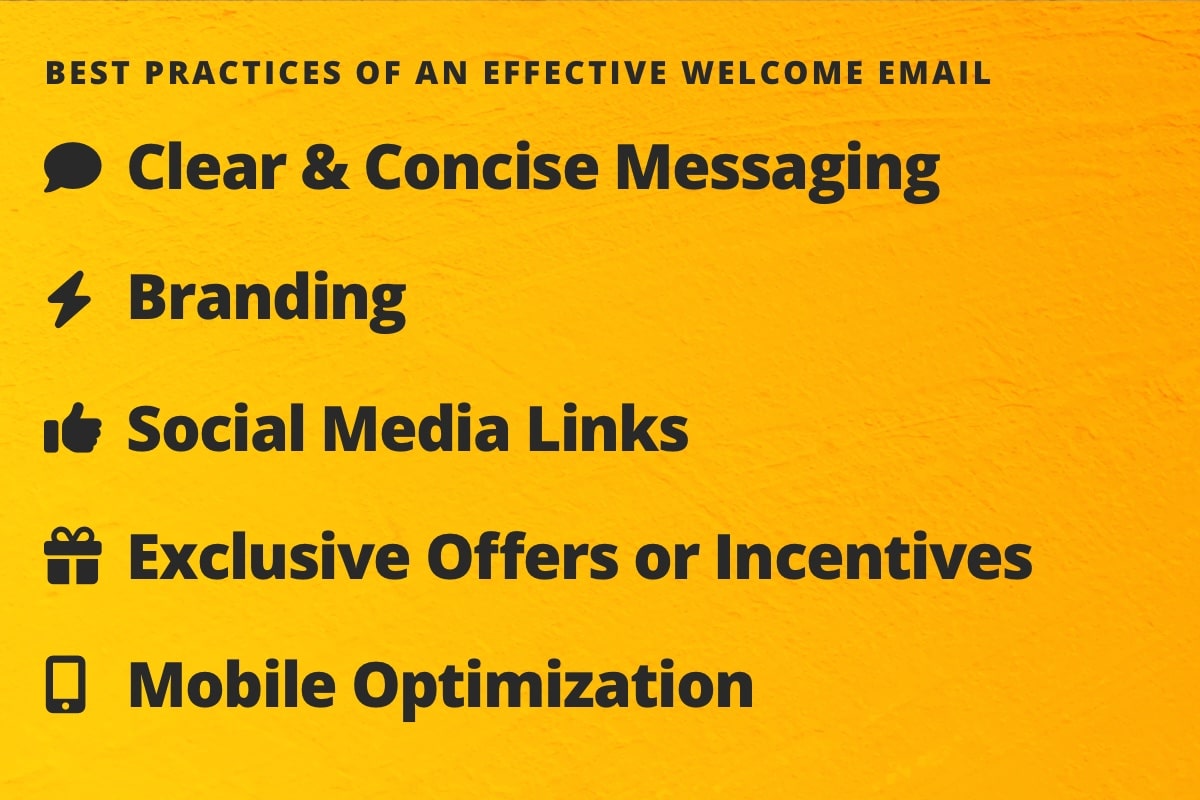
- Clear and concise messaging: Your welcome email should be quick and easy to scan and understand. Avoid lengthy paragraphs or complex language that may overwhelm your recipient. Instead, use short sentences and bullet points to convey your message in a clear and concise manner.
- Branding: Incorporate your brand’s visual identity into the design of your welcome email. This includes using consistent colors, fonts, and images that reflect your brand’s personality and values. By doing so, you establish a strong brand presence right from the start, making it easier for recipients to recognize and remember you.
- Social media links: Including links to your social media profiles in your welcome email can encourage new subscribers to further connect and engage with your brand beyond their inbox. This allows them to explore additional content or connect with you on various platforms where they might feel more comfortable interacting.
- Exclusive offers or incentives: Providing new subscribers with exclusive discounts, freebies, or special promotions can significantly increase their interest in engaging further with your business. Consider offering these incentives as a way of showing appreciation for their subscription while also enticing them to take action.
- Mobile optimization: With an increasing number of people accessing emails through mobile devices, it’s crucial that your welcome email is optimized for mobile viewing as well as desktop viewing. Ensure that the layout remains visually appealing across different devices and sizes by using responsive design techniques.
Creating Your First Welcome Email
Now that you have a clear understanding of some of the best practices involved in creating your first welcome email, let’s dive deeper into each step to ensure you are equipped with all the necessary information and resources.
Step 1: Set your goal
Before starting to write your welcome email, it’s crucial to define the objective behind sending this email. Ask yourself what you want to achieve with this communication. Do you aim to drive sales by promoting a specific product or offer? Are you looking to increase website traffic and encourage recipients to explore more about your brand? Or do you simply want to introduce your business and establish an initial connection with new subscribers? Clearly identifying your goal will confirm your focus and help shape the content and tone of your welcome email.
Step 2: Choose the right email marketing platform
To efficiently manage and execute your email marketing strategy, it is essential to select an appropriate platform that aligns with your needs. With various options available such as Hubspot, MailChimp, or Constant Contact, these platforms not only provide user-friendly interfaces but also come equipped with pre-designed templates and analytics tools. These features allow for easy customization of emails while providing valuable insights into campaign performance metrics.
Step 3: Craft an engaging welcome email
With a defined goal in mind, it’s time to craft a compelling welcome email that captures the attention of recipients from the moment they open it. Remembering the key components mentioned earlier, focus on writing content that introduces customers not only to who you are as a brand but also what they can expect from your future communications.
Begin by simply expressing gratitude for their decision to subscribe or purchase, thereby acknowledging their initial engagement. Then, provide a succinct introduction to your brand and its values, ensuring that your narrative aligns with the customer’s expectations.
Also, be sure to highlight the unique benefits they will receive, be it valuable insights, exclusive deals, or early access to new products or services. By doing so, you create a sense of anticipation and excitement about future communications.
Moreover, consider incorporating a clear call-to-action (CTA) that guides them toward the next steps, whether it’s following your brand on social platforms, browsing through your latest collection, or sharing their preferences to personalize their experience.
Lastly, keep in mind that a well-crafted welcome email isn’t just a one-off communication but the starting point of an ongoing relationship with your customer. Therefore, strive to create an email that resonates with your audience and sets the right tone for future interactions.
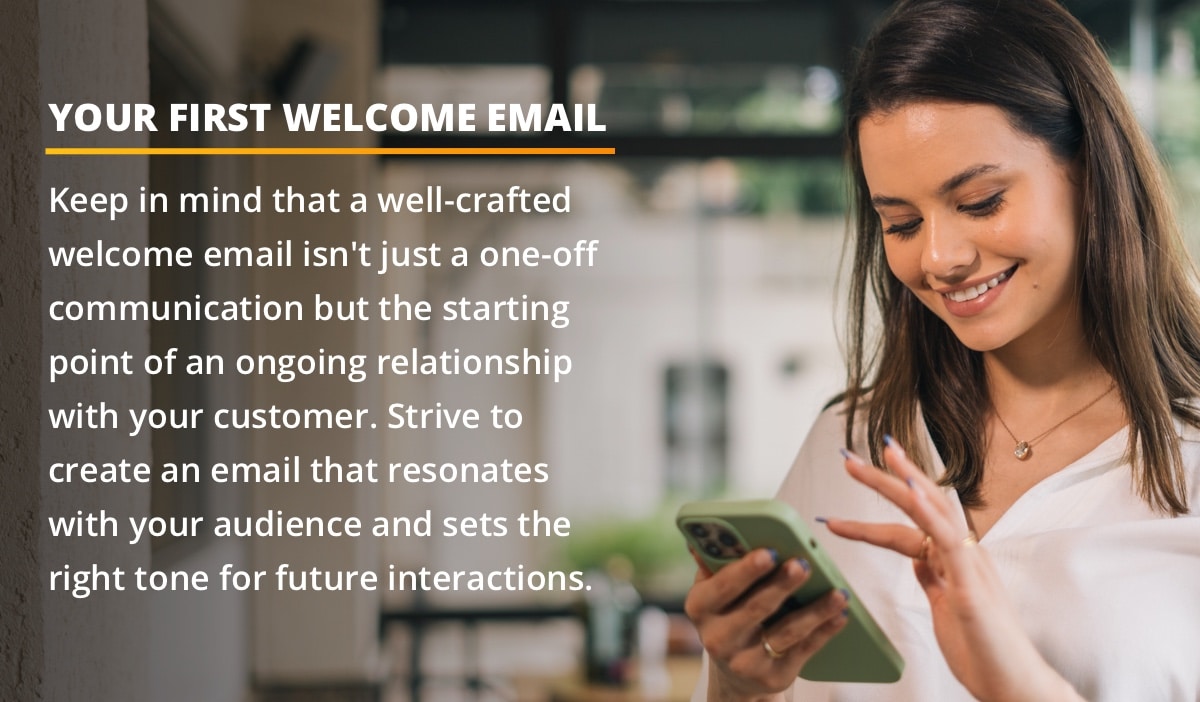
More Tips for Welcome Emails
Here are some additional tips:
Create a series
Creating a series of automated drip emails can be an effective strategy to build engagement and nurture relationships with your audience over time. By sending a sequence of carefully crafted messages, you have the opportunity to gradually introduce new subscribers to your brand, share valuable content, and ultimately convert them into loyal customers.
When designing your email series, it is important to keep in mind that each message should provide unique value while maintaining a consistent tone and branding. Consider staggering the frequency of these emails to ensure that you are not overwhelming your recipients or causing them to lose interest. Instead, aim for a well-paced flow of information that keeps your subscribers engaged without inundating their inbox.
The beauty of a drip email series lies in its ability to tell a story or guide subscribers through specific stages of the customer journey. You can use this opportunity to showcase different aspects of your products or services, highlight customer success stories or testimonials, offer exclusive promotions or discounts, and even provide helpful tips related to their interests.
Personalize
Personalization is another key factor in creating an impactful drip email series. By tailoring your welcome emails to each recipient, you can provide great value, establish a deeper connection, and make them feel valued as customers or subscribers. To achieve this level of personalization, it’s crucial to take advantage of any available data that you have on your audience.
Start by segmenting your subscriber list based on relevant criteria such as demographics, interests, past purchases, or engagement history. This will allow you to send targeted welcome emails that speak directly to the specific needs and preferences of different groups within your audience.
Incorporating dynamic content into your welcome emails can also enhance personalization. Utilize merge tags or variable fields to automatically insert personalized information such as the recipient’s name, location, or previous interactions with your brand. This small touch can go a long way in making recipients feel acknowledged and appreciated right from the start.
Additionally, consider leveraging behavioral data collected from website tracking or previous email interactions. For example, if a visitor has abandoned their shopping cart without completing a purchase before subscribing to your newsletter, including personalized product recommendations related to their browsing history in the welcome email could entice them back for conversion.
Beyond just using data for personalizing content within the email itself, consider employing automated triggers based on user behavior or milestones reached. For instance, sending a special offer or exclusive discount code when someone makes their first purchase after signing up can foster loyalty and encourage further engagement with your brand.
Offer a discount
One effective strategy to enhance the impact of your welcome emails is to offer a special discount or promotion. By providing customers with an exclusive deal or incentive, you can motivate them to take action and make their first purchase sooner rather than later.
Discounts are a powerful tool as they create a sense of urgency and immediate value for the customer. Whether it’s a percentage off their total purchase, free shipping, or a buy-one-get-one offer, these enticing perks can significantly increase conversion rates and drive sales right from the start.
Remember that while discounts can be highly effective in attracting new customers, it’s crucial not to devalue your products or services excessively. Striking a balance between offering attractive savings without compromising perceived quality will help maintain long-term customer loyalty.
Utilize the power of social proof
Showcase social proof through customer testimonials or reviews to build trust. Including positive feedback from satisfied customers can significantly impact potential customers’ perception of your brand, products, or services.
By featuring authentic testimonials or reviews in your welcome email, you provide new subscribers with real-life experiences and opinions from individuals who have already interacted positively with your business. This social proof not only reassures newcomers but also demonstrates that others have had a positive experience and are willing to vouch for your offerings.
When selecting which testimonials or reviews to include in your welcome email, prioritize those that align with the specific benefits or features highlighted earlier in the email content. By doing so, you further reinforce the value proposition presented while catering to the different interests and needs of individual subscribers.
To maximize the impact of these customer endorsements, consider incorporating visual elements such as profile pictures alongside their testimonial quotes. These visuals help humanize the feedback and make it more relatable for readers.
Don’t shy away from including diversity within these testimonials—featuring a range of demographics and backgrounds can resonate with a broader audience. Potential customers often seek validation from people they can relate to or aspire towards connecting with diverse voices enhances inclusivity within your marketing approach.
Remember that transparency is key; ensure that all testimonials featured are genuine representations of customers’ experiences rather than fabricated endorsements. Authenticity builds trust among readers and prevents any skepticism regarding staged praise.
A Few Common Mistakes to Avoid
Avoid these common mistakes when crafting your welcome emails:
Do not delay
Sending your welcome email promptly is crucial for effective marketing. The timing of this initial communication can significantly impact the success of your overall marketing strategy. Therefore, it is essential to prioritize sending the welcome email as soon as possible.
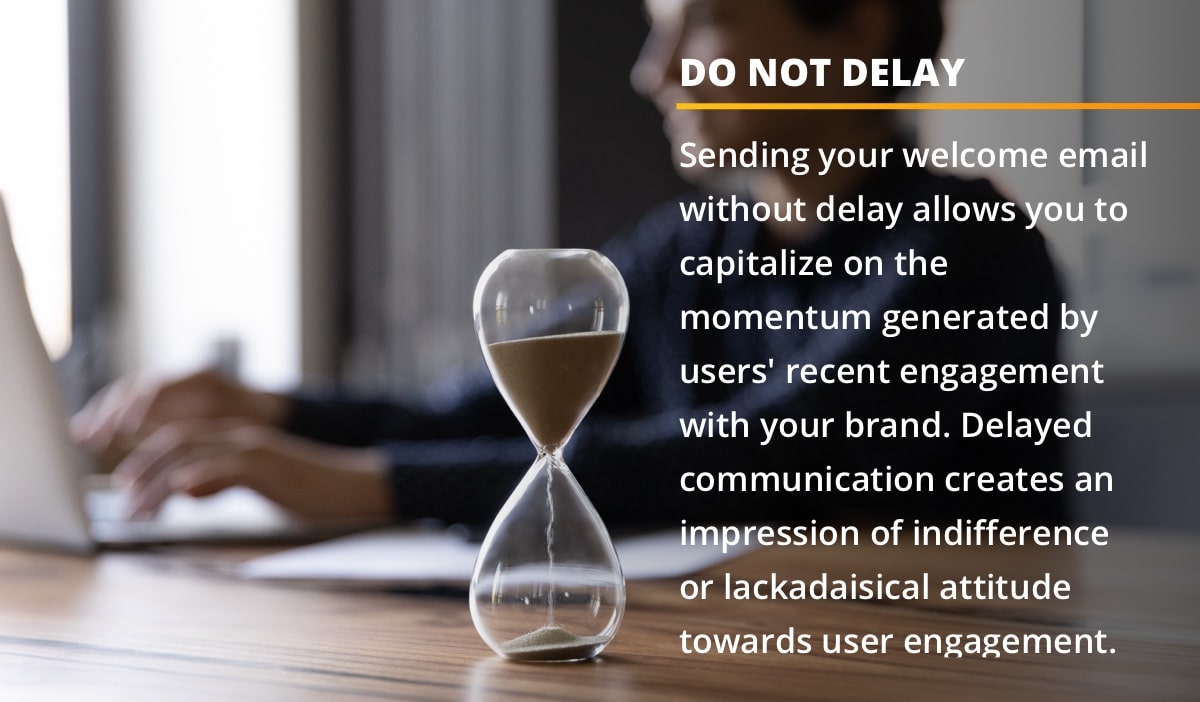
By promptly delivering the welcome email, you demonstrate professionalism and efficiency, making a positive first impression on new users. This immediate response shows that you value their interest and are committed to providing exceptional customer experience right from the start.
Sending your welcome email without delay also allows you to capitalize on the momentum generated by users’ recent engagement with your brand. It ensures that they have a fresh recollection of their interaction when they receive this follow-up message. By striking while the iron is hot, you increase the chances of converting these interested individuals into loyal customers or clients.
Delayed welcome emails may lead to missed opportunities and potential customer disengagement. If there’s a significant gap between sign-up and receiving a welcome message, users might lose interest or forget about their initial intention entirely. Delayed communication creates an impression of indifference or lackadaisical attitude towards user engagement—an unfavorable perception for any business aiming to build strong relationships with its audience.
Don’t be too salesy
Instead of using this initial interaction solely as a platform for aggressively pushing products or services, seize the opportunity to genuinely introduce your brand and establish a meaningful connection with your audience. Welcome emails are an ideal chance to showcase the value that your brand can provide and demonstrate how you can assist and support your customers in their journey.
By focusing on offering helpful information, tips, or resources relevant to their needs or interests, you can foster trust and credibility from the very beginning. Avoid bombarding recipients with excessive promotional content or overwhelming them with pressure to buy now. Instead, prioritize building rapport first by providing useful insights or personalized recommendations based on their preferences.
Remember that welcome emails set the tone for future interactions between your brand and its subscribers. By taking a helpful approach rather than aggressively pursuing immediate sales, you lay a foundation for long-term trust and loyalty.
Crafting an effective welcome email is both an art and a science. By incorporating the key components discussed, you can create a compelling introduction that not only resonates with your new subscribers but also sets the stage for a fruitful ongoing relationship. Remember, the first impression counts, and a well-designed welcome email is your first step toward building a long-term and mutually beneficial relationship.
Most Popular Articles

Seeing Favicons in Your Google Search Results? Here’s Why…
Have you noticed anything different in your Google Search results lately? Google added tiny favicon icons to its organic search results in January. It was…

Business Growth and Digital Marketing News & Tips 11-17-24
Are you encouraging and rewarding innovation? Lee Cockerell is the former Executive Vice President of Operations at Walt Disney World. A lover of traditional red…

Business Growth and Digital Marketing News & Tips 11-27-24
A culture of gratitude "Feeling gratitude and not expressing it is like wrapping a present and not giving it." – William Arthur Ward Beyond being…








